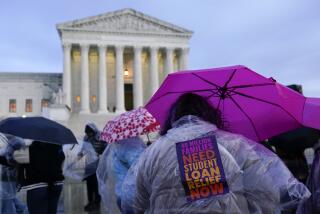Lenders lack incentive to halt some foreclosures
- Share via
Government initiatives to stem the country’s mounting foreclosures are hampered because banks and other lenders in many cases have more financial incentive to let borrowers lose their homes than to work out settlements, some economists have concluded.
Policymakers often say it’s a good deal for lenders to cut borrowers a break on mortgage payments to keep them in their homes. But, according to researchers and industry experts, foreclosing can be more profitable.
The problem is that modifying mortgages is profitable to banks for only one set of distressed borrowers, while lenders deal with three types. Modification makes economic sense for a bank or other lender only if the borrower can’t sustain payments without it, yet will be able to keep up with new, more modest terms.
A second set are those who are likely to fall behind on their payments again even after receiving a modified loan and will probably lose their homes one way or another. Lenders don’t want to help these borrowers because waiting to foreclose can be costly.
Finally, there are those delinquent borrowers who can somehow, even at great sacrifice, catch up without a modification. Lenders have little financial incentive to help them.
These financial calculations on the part of lenders pose a challenge for President Obama’s ambitious efforts to address the mortgage crisis, which remains at the heart of the country’s economic troubles and continues to upend millions of lives. Senior officials at the Treasury Department and the Department of Housing and Urban Development on Tuesday extracted a pledge from 25 mortgage company executives to do more to help borrowers in danger of foreclosure.
The administration is seeking to influence lenders’ calculus in part by offering them billions of dollars in incentives to modify home loans. Still, foreclosed homes continue to flood the market, forcing down home prices. That contributed to the unexpectedly large jump in new-home sales in June, reported Monday by the Commerce Department.
“There has been this policy push to use modifications as the tool of choice,” said Michael Fratantoni, vice president of single-family-home research at the Mortgage Bankers Assn. But “there is going to be this narrow slice of borrowers for which modifications is the right answer.” The size of that slice is tough to discern, he said. “The industry and policymakers have been grappling with that.”
The effort to understand the dynamics of the mortgage business comes as the administration is prodding lenders to do more to help borrowers under its Making Home Affordable plan, which gives lenders subsidies to lower the payments for distressed borrowers. About 200,000 homeowners have received modified loans since the program began in March, while more than 1.5 million borrowers were subject during the first half of the year to some form of foreclosure filings, from default notices to completed foreclosure sales, according to RealtyTrac.
No doubt part of the explanation is that lenders are overwhelmed by the volume of borrowers seeking to modify their mortgages. Rising unemployment and falling home prices have added to the problem.
But a study released last month by the Federal Reserve Bank of Boston was downbeat on the prospects for widespread modifications. The analysis, which looked at the performance of loans in 2007 and 2008, found that lenders lowered the monthly payments of only 3% of delinquent borrowers, those who had missed at least two payments. Lenders tried to avoid modifying the loans of borrowers who could “self-cure,” or catch up on their payments without help, and those who would fall behind again even after receiving help, the study found.
Nearly a third of the borrowers who miss two payments are able to self-cure without help from their lender, according to the Boston Fed study. Separately, Moody’s Economy.com, a research firm, estimated that about a fifth of those who miss three payments will self-cure.
The borrowers who are most determined to meet their obligations are often unlikely candidates for loan modifications.
“These are the people who will get a second job, borrow from their family to keep up,” said Paul S. Willen, a senior economist at the Federal Reserve Bank of Boston and an author of its report. “From a coldblooded profit-maximizing standpoint, these are the people the banks will help the least.”
More to Read
Inside the business of entertainment
The Wide Shot brings you news, analysis and insights on everything from streaming wars to production — and what it all means for the future.
You may occasionally receive promotional content from the Los Angeles Times.










